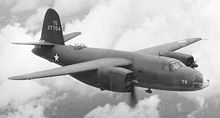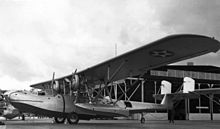Glenn L. Martin Company - Picture

|
|

Picture - The B-26 Marauder, a bomber produced by Martin during World War II.
Glenn L. Martin Company
Fate Merged with American-Marietta Corporation
Founded: 1912
Defunct: 1961
Headquarters: Santa Ana, California

Picture - The Vanguard rocket, designed and built by Martin for Project Vanguard, prepares to launch Vanguard 1.
The Glenn L. Martin Company was an American aircraft and aerospace manufacturing company that was founded by the aviation pioneer Glenn L. Martin. The Martin Company produced many important aircraft for the defense of the United States and its allies, especially during World War II and the Cold War. Also, during the 1950s and 60s, the Martin Company moved gradually out of the aircraft industry and into the guided missile, space exploration, and space utilization industries.
The Martin Company has gone through two large mergers with other corporations for the 1960 through the 1990s, with its name changed somewhat both times. In 1961, the Martin Company merged with the American Marietta Company, a large sand and gravel mining company - because both companies wanted to diversify into the other areas and thus avoid the economic ups and downs of both, to a certain degree. The daughter company was named the Martin Marietta Corporation.
Then, in 1995, Martin Marietta merged with another very large aerospace company, the Lockheed Corporation. This was because during the 1990s, the amount of business available for aerospace companies was declining to a very large degree, especially following the Fall of the Soviet Union. The daughter of these two corporations is called the Lockheed Martin Corporation.
History
Glenn L. Martin Company was founded by aviation pioneer Glenn Luther Martin on August 16, 1912. Martin started out building military trainers in Santa Ana, California, and then in 1916, Martin accepted a merger offer from the Wright Company, creating the Wright-Martin Aircraft Company in September. This new company did not go well, and Glenn Martin left it to form a second Glenn L. Martin Company on September 10, 1917. This time based in Cleveland, Ohio. (Later, its headquarters would be moved to Baltimore, Maryland.)
Martin's first big success came during World War I with the MB-1 bomber, a large biplane design ordered by the US Army on January 17, 1918. The MB-1 entered service after the end of hostilities, but a follow up design, the MB-2, was also proved successful and 20 were ordered by the Army Air Service, the first five of them under the company designation and the last 15 as the NBS-1 (Night Bomber, Short range). Although the War Department ordered 110 more, it retained the ownership rights to the design and put the order out for bid. Unfortunately for Martin, the production orders were given to other companies that had bid lower, Curtiss (50), L.W.F. Engineering (35), and Aeromarine (25). The design was the only standard bomber used by the Air Service until 1930 and was used by seven squadrons of the Air Service/Air Corps: four in Virginia, two in Hawaii, and one in the Philippines.
In 1924 the Martin Company underbid Curtiss for the production of a Curtiss-designed scout bomber, the SC-1, and ultimately Martin produced 404 of these. In 1929 Martin sold the Cleveland plant and built a new one in Middle River, Maryland, northeast of Baltimore.
During the 1930s, Martin built flying boats for the U.S. Navy, and the innovative Martin B-10 bomber for the Army. The Martin Company also produced the noted China Clipper flying boats used by Pan American Airways for its transpacific San Francisco to the Philippines route.
During World War II, a few of Martin's most successful designs were the B-26 Marauder and A-22 Maryland bombers, the PBM Mariner and JRM Mars flying boats, widely used for air-sea rescue, anti-submarine warfare and transport.
The Martin Company built a total of 531 B-29 Superfortresses and 1,585 B-26 Marauders at its Omaha, Nebraska, plant at Offutt Field. Among the B-29s manufactured there were the Enola Gay and Bocks Car which dropped the two war-ending atomic bombs on Hiroshima and Nagasaki, Japan.
Postwar efforts in aeronautics by the Martin Company included two unsuccessful prototype bombers, the XB-48 and the XB-51, the successful B-57 Canberra tactical bombers, both the P5M Marlin and P6M SeaMaster seaplanes, and the Martin 4-0-4 twin-engine passenger airliner.
The Martin Company moved forward into the aerospace manufacturing business, and it produced the Vanguard rocket, which was used by the American space program as one of its first satellite booster rockets as part of Project Vanguard. The Vanguard was the first American space exploration rocket designed from scratch to be an orbital launch vehicle - rather than being a modified sounding rocket (like the Juno I) or a ballistic missile (like the U.S. Army's Redstone missile). Martin also designed and manufactured the huge and heavily-armed Titan I and LGM-25C Titan II Intercontinental Ballistic Missiles (ICBMs).
The Martin Company was also one of two finalists for the Command and Service Modules of the Apollo Program. Unfortunately for Martin, NASA awarded the design and production contractis for these to the North American Aviation Corporation.
The Martin Company went further in the production of even larger booster rockets for the National Aeronautics and Space Administration and the U.S. Air Force with its Titan III series of over 100 rockets produced, including the Titan IIIA, the more-important Titan IIIC, and the Titan IIIE. Besides hundreds of Earth satellites, these rockets were essential for the sending to outer space of the two space probes of the Voyager Project to the outer planets the two space probes of the Viking Project to Mars, and the two Helios probes into low orbits around the Sun. (closer, evem, than Mercury (planet).
Finally the U.S. Air Force required a booster rocket that could launch heavier satellites than either the Titan IIIE or the Space Shuttle. The Martin Company responded with its extremely large Titan IV series of rockets. When the Titan IV came into service, it could carry a heavier payload to orbit than any other rocket except for NASA's Saturn V rocket - which was no longer in production and thus was a machine from history. Besides its use by the Air Force to launch its sequence of very heavy reconnaissance satellites, one Titan IV, with a powerful Centaur rocket upper stage, was used to launch the heavy Cassini space probe to the planet Saturn in 1997. The Cassini probe has been in orbit around Saturn since 2004, successfully returning mountains of scientific data.
With the halting of production of the Martin Company's Titan IV in 2004, no rocket can carry a heavier payload than the Space Shuttle, and that program is also soon to come to an end (in 2011).
The Martin Company merged with the American Marietta Corporation (NOT an aerospace company) in 1961 to form the Martin Marietta Corporation. In 1995, this one itself merged with the Lockheed Corporation to form the Lockheed Martin Corporation. American Marietta had been a large sand and gravel mining company, and of course, Lockheed was another large aerospace company.
Something that can be somewhat confusing is that the Martin Marietta Corporation never has had anything to do with Marietta, Ga., or the State of Georgia.
The Martin Company employed many of the founders and chief engineers of the American aerospace industry, including Dandridge M. Cole, Donald Douglas, Lawrence Bell, James S. McDonnell, J.H. "Dutch" Kindleberger (North American Aviation), Hans Multhopp, and C.A. Van Dusen (Brewster Aeronautical Corporation). Martin also taught William Boeing how to fly and also sold him his first airplane.
Products
Trainer planes
Martin T
Martin S
Attack planes
Martin T3M
Martin T4M
Martin BM
Martin AM Mauler
Bombers
Martin MB
Martin B-10
Martin XB-16
Martin 167 Maryland
Martin 187 Baltimore
Martin B-26 Marauder
Martin XB-33 Super Marauder
Martin XB-48
Martin XB-51
Martin B-57 under license from English Electric (British)
Martin Model 316 (XB-68)
Military seaplanes

Picture - Martin P3M-2
Martin PM
Martin P3M
Martin PBM Mariner
Martin JRM Mars
Martin P4M Mercator (land plane)
Martin P5M Marlin
Martin P6M SeaMaster
Civil aviation airliners
Martin M-130 China Clipper
Martin M-156
Martin 2-0-2
Martin 4-0-4
Airplane engines
Martin 333 a four-cylinder inverted in-line piston engine
Intercontinental Ballistic Missiles
Titan I
Titan II
Booster rockets
The four-stage Vanguard rocket
Titan III
Titan IV
In addition, after the removal of 54 Titan IIs from alert status as ICBMs in the mid-1980s, about 50 of them were used as satellite launchers by the U.S. Air Force. The rest of them were either scrapped or used as museum pieces, such as at the Kansas Cosmosphere in Hutchinson, Kansas.
Glenn L. Martin Company Pictures and Glenn L. Martin Company for Sale.
Living Warbirds: The best warbirds DVD series.
Source: WikiPedia